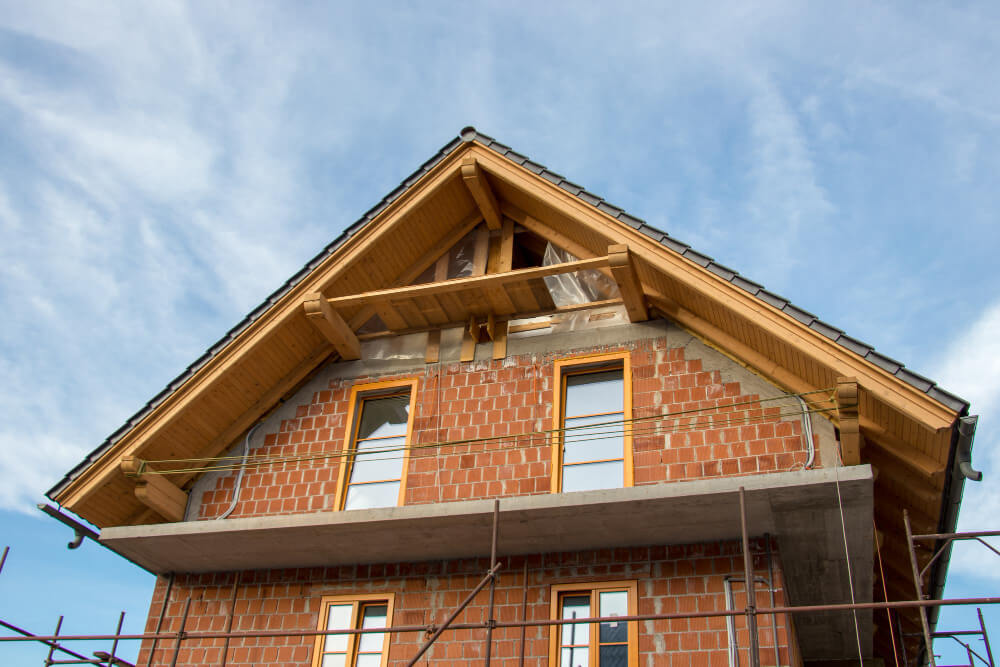How to Find Out What Year Your House Was Built
Updated Fri, Oct 24, 2025 - 22 min read
Top blog articles
Discovering when your house was built isn’t just satisfying curiosity; it’s essential information that affects everything from insurance rates and property taxes to renovation planning and home values. Whether you’re buying, selling, or improving your property, knowing your home’s age helps you make informed decisions about maintenance, upgrades, and investments.
This comprehensive guide shows homeowners, real estate professionals, and contractors exactly how to research a property’s construction date using multiple reliable methods. You’ll learn which sources provide the most accurate information and how to use this knowledge to protect your investment and plan effectively.
Why This Matters: Your home’s age directly impacts insurance costs, renovation requirements, property values, and legal compliance issues. Smart property decisions start with knowing exactly when your house was built.
Quick Reference: Where to Find Your Home’s Build Date
| Method | Difficulty | Accuracy | Time Required | Cost |
|---|---|---|---|---|
| Property Deed/Title | Easy | High | 5-10 minutes | Free |
| County Assessor Records | Easy | High | 10-15 minutes | Free |
| Building Permit Records | Moderate | Very High | 15-30 minutes | Free-$25 |
| MLS/Real Estate Websites | Easy | Moderate | 5 minutes | Free |
| Appraisal Reports | Easy | High | 5 minutes | Free (if you have them) |
| Insurance Documents | Easy | High | 5 minutes | Free (if you have them) |
| Historical Society | Moderate-Hard | Variable | Hours-Days | Free-$50 |
| Professional Research | Easy | Very High | Days-Weeks | $200-$1,000+ |
Most homeowners can determine their home’s age in under 30 minutes using free online resources.
Why Knowing Your Home’s Construction Date Is Critical
Understanding your property’s age provides essential insights that affect both immediate decisions and long-term planning strategies.
Financial Impact of Home Age
Property Valuation and Market Appeal:
- Homes from certain eras may command premium prices due to architectural significance
- Age affects depreciation calculations and assessed property values
- Historic designation can provide tax benefits, but may limit renovation options
- Market trends favor different age ranges depending on location and buyer preferences
Insurance and Risk Assessment: Insurance companies adjust premiums based on construction date because older homes often have:
- Outdated electrical systems that increase fire risk
- Aging plumbing that’s prone to failures and water damage
- Structural materials that may not meet current building codes
- HVAC systems that are less efficient and more failure-prone
According to Insurance Information Institute data, homes built before 1960 typically face 15-25% higher insurance premiums than comparable newer homes due to these increased risks.
Tax Implications:
- Some jurisdictions offer property tax reductions for historic properties
- Age affects assessment methods and depreciation schedules
- Certain improvement tax credits may only apply to older homes
- Estate planning considerations may vary based on property age
Practical Benefits for Homeowners
Renovation and Improvement Planning:
- Determines which building codes applied during original construction
- Helps identify likely maintenance issues based on typical material lifespans
- Guides compatibility decisions for additions and major renovations
- Affects permit requirements and inspection processes
Planning a renovation? Use our cost calculators to budget for age-appropriate improvements:
- Kitchen Remodel Costs – Factor in older plumbing and electrical updates
- Bathroom Renovation Costs – Account for vintage fixtures and layouts
- Room Addition Costs – Ensure compatibility with existing structure
Safety and Compliance Considerations:
- Identifies the potential presence of hazardous materials like asbestos or lead paint (EPA notes homes built before 1978 likely contain lead-based paint)
- Helps assess structural integrity based on the construction methods of the era
- Determines if electrical, plumbing, or HVAC systems need updating
- Guides emergency preparedness based on building vulnerabilities
Maintenance Scheduling:
- Predicts when major systems will need replacement or significant repair
- Helps budget for anticipated maintenance costs
- Identifies priorities for preventive maintenance programs
Essential Methods to Research Your Home’s Age

Multiple reliable sources can provide your home’s construction date, and using several methods helps verify accuracy and completeness.
Method 1: Review Your Property Documentation
Homeownership Paperwork Sources: The most accessible starting point involves documents you likely already possess.
Title and Deed Documents:
- Property deed typically lists the construction date or the year built
- Title insurance policies often include property age information
- Previous title searches may show the construction timeline
- Chain of title documents can reveal when the building first appears in records
Purchase and Mortgage Documents:
- Home appraisal reports include detailed property age information
- Mortgage applications require accurate construction dates
- Home inspection reports typically verify and note the property age
- Purchase agreements may reference age in property descriptions
Insurance Records:
- Homeowner’s insurance applications require accurate construction dates
- Insurance companies often verify ages through independent research
- Policy documents maintain this information for risk assessment purposes
How to Access: Check your closing documents folder, safe deposit box, or request copies from your title company or lender.
Method 2: Search Online Real Estate Databases
Free Public Access Tools: The easiest way to find your home’s age is through online property databases.
What You’ll Find:
- Year built (based on county assessor records)
- Property characteristics and square footage
- Sale history and price trends
- Tax assessment information
- Sometimes, renovation and permit history
Accuracy Note: These sites pull data from county assessor records, which are generally reliable but occasionally contain errors. Always verify with official sources for critical decisions.
Method 3: Research County Assessor Records
Property Tax Assessment Databases: County assessors maintain the most authoritative records for property age and characteristics.
How to Access Assessor Records:
- Visit your county assessor’s website
- Search by property address or Assessor’s Parcel Number (APN)
- Review the property details page
- Look for the “Year Built” or “Effective Year Built” field
What Assessor Records Reveal:
- Original construction date
- Subsequent additions and improvements
- Square footage changes over time
- Historical assessed values
- Property classification and zoning
Finding Your County Assessor:
- Google “[Your County] County Assessor” + “property search”
- Visit your county government website
- Check the National Association of Counties directory
Understanding “Effective Year Built”: Some assessor records show an “Effective Year Built” date that differs from the original construction date. This typically indicates major renovations or rebuilds that substantially changed the property.
Method 4: Research Building Permit Records
Local Government Permit Databases: Building permits provide the most authoritative source for construction dates since they document official approval to begin construction.
How to Access Permit Records:
- Visit your city or county building department website
- Search permit databases using your property address or parcel number (APN)
- Review both original construction permits and subsequent renovation permits
- Look for foundation or framing permits that indicate start of construction
What Permit Records Reveal:
- Original building permit date (most accurate construction start date)
- Subsequent addition and renovation permits
- Changes in ownership are reflected in permit applications
- Evolution of property improvements over time
- Contractor and architect information
Accessing Historic Permit Information: Older permits may require:
- In-person visits to city/county offices for archived records
- Requests for paper file research for pre-digital permits
- Consultation with planning department staff for interpretation
- Cross-referencing with assessor records for verification
Digital vs. Paper Records: Many jurisdictions have digitized permits from the 1980s onward, but older permits may only exist in paper archives or microfilm.
Method 5: Utilize Professional Property Research Services
Real Estate Professional Resources: Licensed real estate agents have access to comprehensive property databases not available to the general public.
Multiple Listing Service (MLS) Data:
- Contains detailed property histories, including construction dates
- Shows previous sale records with age information
- Includes professional appraisal data from past transactions
- Provides comparative market analysis with age-related valuations
Professional Property Research:
- Real estate attorneys can access court and legal records
- Licensed appraisers maintain property research resources
- Title companies have extensive historical property databases
- Property management companies often maintain detailed building histories
When to Use Professionals:
- Historic properties with unclear records
- Complex ownership histories
- Legal proceedings requiring certified information
- Commercial properties needing detailed due diligence
Method 6: Government Records and Public Databases
Additional Government Resources Beyond Assessor:
County Recorder’s Office:
- Maintains deed records and property transfers
- Shows chain of ownership from original construction
- Includes mortgage and lien information
- Often has indexed records searchable by address
GIS (Geographic Information Systems) Mapping:
- Many counties provide interactive property maps
- Shows parcel boundaries and building footprints
- Includes zoning, flood zone, and overlay district information
- May show construction dates on property detail pages
Online Database Access: Most counties provide online access to:
- Property assessment records through assessor websites
- GIS mapping systems with property details
- Historical tax records showing property evolution
- Zoning and land use information
Method 7: Historical and Archival Research
Local Historical Societies: Community organizations often maintain extensive property records, especially for older homes.
Resources Available:
- Historical photographs showing construction timelines
- Local newspaper archives with construction announcements
- Community development records and planning documents
- Oral histories from long-time residents
- City directories showing when addresses first appear
Library and Archive Resources:
- National Register of Historic Places for historically significant properties
- State historical preservation office records
- University archives with local development history
- Genealogical society records that may include property information
Specialized Research Tools:
- Sanborn Fire Insurance Maps: Detailed property maps from 1867-1970s showing building footprints, materials, and construction details
- Historic Tax Records: Property value increases often indicate when buildings were constructed
- City Directories: Historical “phone books” listing residents by address, helping date when buildings first appeared
- Census Records: May include property information and construction details
When Historical Research Is Necessary:
- Homes built before 1900
- Properties in historic districts
- Disputed or unclear official records
- Properties with significant historical value
- Homes suspected to be older than records indicate
Specialized Research Services:
- Professional genealogists who research property histories
- Architectural historians familiar with local construction trends
- Title search companies with extensive historical databases
Method 8: Architectural Analysis and Physical Clues
Reading Your Home’s Physical Features: Architectural styles and construction methods provide clues about the construction era.
Architectural Style Dating:
- Victorian (1837-1901): Ornate details, steep roofs, bay windows, decorative trim
- Craftsman/Bungalow (1905-1930): Low-pitched roofs, exposed rafters, built-in furniture
- Colonial Revival (1880-1955): Symmetrical facades, columns, multi-pane windows
- Ranch (1945-1970): Single-story, open floor plans, attached garages
- Split-Level (1950s-1970s): Multiple levels, partial staircases
- Contemporary (1970s-present): Open plans, large windows, mixed materials
Construction Material Clues:
- Knob-and-tube wiring: Pre-1930s
- Cast iron plumbing: Pre-1960s
- Galvanized steel pipes: 1930s-1960s
- Aluminum wiring: 1960s-1970s (fire hazard)
- Copper plumbing: 1950s-present
- PEX plumbing: 1990s-present
Foundation Types:
- Stone foundations: Pre-1900s typically
- Brick foundations: 1900s-1950s
- Poured concrete: 1910s-present
- Concrete block: 1920s-present
Important Note: While architectural analysis provides useful clues, it should never be the sole source for determining the construction date. Always verify with official records.
Leveraging Technology for Property Research

Modern technology provides powerful tools for researching property age and history.
Kukun’s Property Intelligence Tools
Access Comprehensive Property Information:
Kukun Dashboard: Claim your home and access:
- Official construction date and property details
- Renovation history and permit records
- Impact of repairs and remodels on home value
- Forecasted value over the next five years
- Property condition tracking and updates
Kukun iHomeReport: Get detailed insights, including:
- Year your house was built
- Complete renovation project history
- Room additions and structural changes
- Electrical, plumbing, and HVAC upgrades
- Previous owners information (when available)
Why Use Kukun:
- Aggregates data from multiple official sources
- Provides renovation cost estimates based on your home’s age
- Tracks property value changes over time
- Helps plan age-appropriate improvements
- Connects you with qualified contractors experienced with your home’s era
Professional Property History Services
Comprehensive Property Reports: Professional services provide detailed property histories including:
- Complete ownership chain from original construction
- All permits and improvements throughout the property’s life
- Comparable sales analysis with age considerations
- Environmental and zoning compliance history
When to Use Professional Services:
- Historic properties with complex ownership histories
- Commercial properties requiring detailed due diligence
- Properties with suspected undocumented improvements
- Legal proceedings requiring certified property information
Understanding What Your Home’s Age Reveals
Once you know when your house was built, this information provides valuable insights for decision-making.
Construction Era Characteristics
Pre-1950s Construction:
- Often features solid wood framing and plaster walls
- May contain lead paint (pre-1978) and asbestos materials (pre-1980)
- Electrical systems likely need updating for modern loads
- Plumbing may be galvanized steel or cast iron, requiring replacement
- Foundation systems vary widely in quality and design
- Windows are typically single-pane, very inefficient
- Minimal or no insulation in walls
1950s-1970s Construction:
- Introduction of modern conveniences, but with dated systems
- Early aluminum wiring in some homes (significant fire hazard)
- HVAC systems approaching the end of their useful life
- Insulation standards lower than current requirements
- Some structural techniques were later found problematic
- Transition from plaster to drywall
- May have original appliances that consume excessive energy
1980s-2000s Construction:
- Generally good structural integrity with modern materials
- Electrical and plumbing systems still functional but aging
- Energy efficiency improvements over earlier eras
- Building codes closer to current standards
- Maintenance focus on system updates rather than replacement
- Better insulation but still below current standards
- Original systems (HVAC, water heater) likely need replacement soon
Post-2000 Construction:
- Built to relatively current building codes and standards
- Energy efficiency features are becoming more common
- Modern electrical, plumbing, and HVAC systems
- Maintenance focuses on preventive care and warranty issues
- Better insulation and windows
- More efficient appliances and systems
- Open floor plans and modern amenities
Age-Related Maintenance and Improvement Planning
Immediate Priorities Based on Age: Understanding typical lifespans helps prioritize improvements:
Major Systems Lifespans:
- Roofing: 15-30 years (asphalt shingles), 50+ years (tile, metal)
- HVAC systems: 15-25 years for major components
- Water heaters: 8-12 years for tank units, 20+ for tankless
- Electrical panels: 25-40 years before upgrading is recommended
- Plumbing: 50-70 years for copper, 20-50 for galvanized steel
- Windows: 15-30 years depending on quality and material
- Siding: 20-50 years depending on material type
Long-Term Investment Strategy:
- Plan major system replacements based on age and remaining life
- Budget for improvements that add value while maintaining character
- Consider energy efficiency upgrades appropriate for your home’s age
- Prioritize safety improvements for older construction methods
Use our renovation cost calculators to budget for age-appropriate improvements:
- HVAC Replacement Costs
- Electrical Panel Upgrade Costs
- Water Heater Replacement Costs
- Flooring Replacement Costs
Financial Implications of Home Age
Understanding how your property’s age affects financial considerations helps with both immediate decisions and long-term planning.
Insurance Considerations
Age-Based Premium Factors:
- Homes built before 1960 often face 15-30% higher premiums due to outdated systems
- Construction methods and materials affect coverage availability
- Some insurers specialize in older homes with appropriate coverage
- Certain improvements can reduce premiums regardless of home age
Coverage Limitations:
- Older electrical, plumbing, or roofing may require updates for full coverage
- Some insurers won’t cover homes with knob-and-tube wiring or aluminum wiring
- Replacement cost vs. actual cash value affects claim settlements
- Historic properties may need specialized insurance for restoration costs
System Updates That Reduce Premiums:
- Electrical panel upgrades to modern standards
- Plumbing replacements eliminating polybutylene or galvanized pipes
- New roof installations
- Updated HVAC systems
- Security system installation
Property Value and Market Considerations
Age as Value Factor:
- Sweet spots vary by market but often include homes 20-50 years old
- Very new construction may lack established neighborhood character
- Historic homes can command premiums, but with higher maintenance costs
- Age affects buyer financing options and inspection requirements
Renovation Return on Investment: According to National Association of Realtors data, renovation returns vary significantly based on home age:
- Older homes often see better returns from system updates (60-80% ROI)
- Mid-century homes benefit from kitchen and bathroom modernization (65-75% ROI)
- Newer homes focus on cosmetic improvements and efficiency upgrades (50-65% ROI)
- Room additions typically return 50-60% regardless of home age
Tax and Legal Implications
Historic Property Benefits:
- National Park Service tax credits for certified historic structures (up to 20% of rehabilitation costs)
- Local historic district protections and benefits
- State-specific programs for historic property preservation
- Property tax freezes or reductions in some jurisdictions
Compliance Requirements:
- Building code compliance varies based on construction date
- Grandfathered systems may need updates for major renovations
- Environmental regulations affect older properties differently
- Accessibility requirements apply differently based on age and improvements
Working with Professionals Based on Your Home’s Age
Different property ages require different types of professional expertise and services.
For Historic Properties (Pre-1950)
Specialized Professionals:
- Historic preservation contractors familiar with period-appropriate materials
- Environmental specialists for lead and asbestos assessment
- Structural engineers experienced with older construction methods
- Insurance agents specializing in historic property coverage
Key Considerations:
- Maintain historic character while improving functionality
- Use appropriate materials and construction techniques
- Navigate historic district regulations and approval processes
- Balance preservation goals with modern safety requirements
Find contractors experienced with historic homes in your area who understand period-appropriate renovation methods.
For Mid-Century Properties (1950-1980)
Focus Areas:
- Electrical system evaluation and potential upgrades
- HVAC efficiency improvements and system replacement planning
- Insulation and weatherization improvements
- Kitchen and bathroom updates for modern functionality
Professional Services:
- Energy auditors to identify efficiency improvement opportunities
- Licensed electricians for system evaluation and upgrades
- HVAC specialists for system replacement and efficiency improvements
- General contractors experienced with mid-century renovation challenges
For Modern Properties (Post-1980)
Maintenance-Focused Approach:
- Preventive maintenance programs to extend system life
- Energy efficiency improvements and smart home technology integration
- Warranty management and manufacturer service programs
- Modern material and finish upgrades
Red Flags When Researching Property Age
Be aware of situations that require additional investigation or professional assistance.
Documentation Inconsistencies
Warning Signs:
- Different construction dates across various official documents (2+ year discrepancies)
- Major discrepancies between permit records and assessment data
- Missing or incomplete construction permits for the original building
- Property modifications that aren’t reflected in official records
- “Effective year built” differs significantly from actual year built
Investigation Steps:
- Cross-reference multiple official sources
- Look for evidence of major renovations that might affect age determination
- Check for unpermitted additions or modifications
- Consider professional property research services for complex situations
- Request certified property history from title company
Age-Related Property Issues
Immediate Concerns:
- Properties with suspected hazardous materials requiring professional assessment
- Structural issues related to the construction methods of specific eras
- Electrical or plumbing systems that pose safety risks
- Foundation problems common to certain construction periods
- Evidence of major undisclosed renovations or additions
Professional Assessment:
- Home inspectors specializing in older properties
- Environmental consultants for hazardous material testing
- Structural engineers for evaluation of age-related concerns
- Contractors experienced with rehabilitation of older properties
Resources for Continued Property Research

Maintaining ongoing awareness of your property’s history and characteristics supports better long-term decision-making.
Official Government Resources
National Resources:
- Library of Congress for historic maps and property development
- National Archives for federal property records
- Census Bureau for housing data and trends
- Federal Emergency Management Agency for flood and hazard mapping
- National Park Service for historic property designation
State and Local Resources:
- State historic preservation offices for property significance research
- County recorder offices for complete property transaction histories
- Municipal planning departments for zoning and development history
- Local libraries with community development archives
Professional Organizations and Services
Industry Resources:
- American Society of Appraisers for property valuation professionals
- National Association of Home Inspectors for property assessment specialists
- International Association of Assessing Officers for property assessment resources
- National Trust for Historic Preservation for historic property guidance
Technology Tools and Databases
Research Platforms:
- Municipal GIS systems for property mapping and zoning information
- Online permit databases for construction and improvement tracking
- Property history services for comprehensive ownership and improvement records
- Real estate platforms for comparative market analysis and property details
Kukun Property Intelligence:
- Kukun Dashboard – Claim and track your property
- Kukun iHomeReport – Access complete property history
- Renovation Cost Calculators – Budget age-appropriate improvements
- Contractor Network – Find era-specific specialists
Frequently Asked Questions
How can I find out when my house was built for free?
The easiest free methods are: (1) Check county assessor records online, (2) Search your address on Kukun, (3) Review your property deed or title documents, or (4) Search building permit records on your city’s website. Most homeowners can find their home’s age in under 20 minutes using these free resources.
Where is the most accurate place to find out when my house was built?
The most accurate source is your city or county building department’s original construction permit, which shows the exact date construction was approved. County assessor records are also highly reliable. Cross-reference multiple official sources for best accuracy.
What if my house has different construction dates in different records?
Different dates may appear for several reasons: (1) “Effective year built” reflects major renovations, not original construction, (2) Additions were built in different years, (3) Permit issue date vs. completion date, or (4) Recording errors. Check building permits for the complete timeline and verify with the county assessor’s office.
How do I find my home’s construction date if it’s very old?
For historic homes, try: (1) Historical society archives, (2) Sanborn Fire Insurance Maps, (3) Historic tax records showing when property values increased, (4) City directories showing when your address first appeared, (5) Local library newspaper archives, or (6) State historic preservation offices. Consider hiring a professional property historian for complex cases.
Does my home’s age affect its value?
Yes, home age significantly affects value. Homes 20-50 years old often represent the sweet spot, while very old homes may need costly updates and very new homes lack established neighborhoods. Historic homes can command premiums but have higher maintenance costs. Use Kukun’s valuation tools to see how age affects your specific property.
Why does my insurance company need to know when my house was built?
Insurance companies use the construction date to assess risk. Older homes often have outdated electrical, plumbing, and roofing systems that increase claims likelihood. Homes built before 1960 typically face 15-30% higher premiums. Some insurers won’t cover homes with specific outdated systems like knob-and-tube wiring.
How does my home’s age affect renovation costs?
Older homes typically cost 20-40% more to renovate due to: (1) Outdated systems requiring updates to meet codes, (2) Hazardous materials like asbestos or lead requiring special handling, (3) Non-standard dimensions requiring custom materials, (4) Hidden issues discovered during work. Use our renovation calculators to estimate age-appropriate project costs.
Can I get tax breaks if my house is historic?
Yes, historic properties may qualify for: (1) Federal rehabilitation tax credits up to 20% through the National Park Service, (2) State historic preservation tax credits, (3) Property tax reductions or freezes, (4) Local historic district benefits. Contact your state historic preservation office for specific programs.
What year was my house built if it has aluminum wiring?
Aluminum wiring was primarily used from the mid-1960s through mid-1970s, with peak usage around 1965-1973. If your home has aluminum wiring, it was likely built during this period. However, always verify with official records as some homes had aluminum wiring installed during renovations.
How do I know if my house has lead paint or asbestos?
According to the EPA, homes built before 1978 likely contain lead paint, and homes built before 1980 may contain asbestos in insulation, tiles, or other materials. Professional testing is the only way to confirm presence. Never disturb suspected materials without professional assessment, especially during renovations.
Making Informed Decisions with Your Property Age Information
Once you’ve determined your home’s construction date, use this information strategically for both immediate needs and long-term planning.
For Home Buyers
Purchase Decision Factors:
- Budget for age-appropriate maintenance and improvements
- Understand insurance implications and coverage requirements
- Plan renovation timeline based on system replacement needs
- Consider resale implications of different age categories
- Factor in potential hidden costs from older systems
Due Diligence Steps:
- Verify age information through multiple sources during inspection period
- Focus inspection on areas based on construction era
- Research neighborhood development patterns and property values
- Understand financing implications for different property ages
- Review permit history for undisclosed additions or renovations
Use Kukun’s property intelligence tools to access comprehensive construction history before buying.
For Current Homeowners
Maintenance and Improvement Strategy:
- Create priority lists based on typical system lifespans for your home’s age
- Budget for major replacements and improvements over time
- Consider energy efficiency improvements appropriate for your construction era
- Plan improvements that enhance value while respecting architectural character
Strategic Renovations Based on Age:
- Pre-1950s homes: Prioritize system updates, lead/asbestos abatement, electrical upgrades
- 1950s-1970s homes: Focus on kitchen and bathroom modernization, HVAC replacement
- 1980s-2000s homes: Energy efficiency upgrades, cosmetic updates, aging system replacements
- Post-2000 homes: Preventive maintenance, warranty management, smart home integration
Insurance and Financial Planning:
- Review insurance coverage for age-appropriate risks and requirements
- Consider property tax implications of improvements and age-related assessments
- Plan estate and inheritance considerations based on property characteristics
- Evaluate refinancing opportunities that consider property age and improvements
Track your property’s value changes and improvement impacts with Kukun Dashboard.
For Real Estate Professionals
Client Service Applications:
- Provide accurate property age information for listing and marketing purposes
- Help clients understand age-related value factors and market positioning
- Guide renovation and improvement recommendations based on construction era
- Assist with insurance and financing considerations related to property age
Market Analysis Integration:
- Use age data for comparable sales analysis and property valuations
- Understand buyer preferences related to different construction eras
- Identify market opportunities in specific age categories
- Provide expertise on age-related disclosure requirements and legal considerations
Conclusion
Discovering your home’s construction date provides essential foundation knowledge for smart property ownership and investment decisions. Whether you’re buying, selling, maintaining, or improving your property, understanding its age helps you make informed choices about insurance, maintenance, renovations, and long-term planning.
The research methods outlined in this guide provide multiple pathways to accurate information, from simple document review to comprehensive professional research. Most homeowners can determine their property’s age in under 30 minutes using readily available free resources, while complex situations may benefit from professional assistance.
Remember: Your home’s age is just the beginning of understanding your property’s characteristics and needs. Use this information as the foundation for ongoing research, maintenance planning, and improvement decisions that protect and enhance your investment over time.
Ready to Make Smart Decisions About Your Home?
Now that you know when your house was built, take the next steps to protect and enhance your investment:
1. Access Your Complete Property History
- Claim your home for free
- View construction date and complete renovation history
- Track property value changes over time
- See forecasted value for the next five years
- Monitor condition and update improvements
- Access detailed property intelligence
- Review all permits and renovations
- Understand previous ownership
- Get comprehensive property analysis
2. Plan Age-Appropriate Renovations
Calculate accurate costs for era-specific improvements:
- Kitchen Remodel Costs – Update vintage layouts and systems
- Bathroom Renovation Costs – Modernize plumbing and fixtures
- Room Addition Costs – Expand while maintaining character
- Electrical Panel Upgrade – Bring older systems up to code
- HVAC Replacement – Improve efficiency in older homes
- All Renovation Calculators – Explore all project options
3. Find Era-Appropriate Contractors
Connect with qualified contractors who understand your home’s specific needs:
- Historic preservation specialists for pre-1950s homes
- System upgrade experts for mid-century properties
- Energy efficiency specialists for all ages
- Verified licenses, insurance, and reviews
- Experience with building permits and inspections
4. Understand Your Property Rights
Learn about restrictions and opportunities:
- Property Zoning Research – What you can build
- Building Permit Process – Required approvals
- Permit Costs Guide – Budget for compliance
Start planning your property improvements with confidence today. Your home’s history is just the beginning of its future potential.









